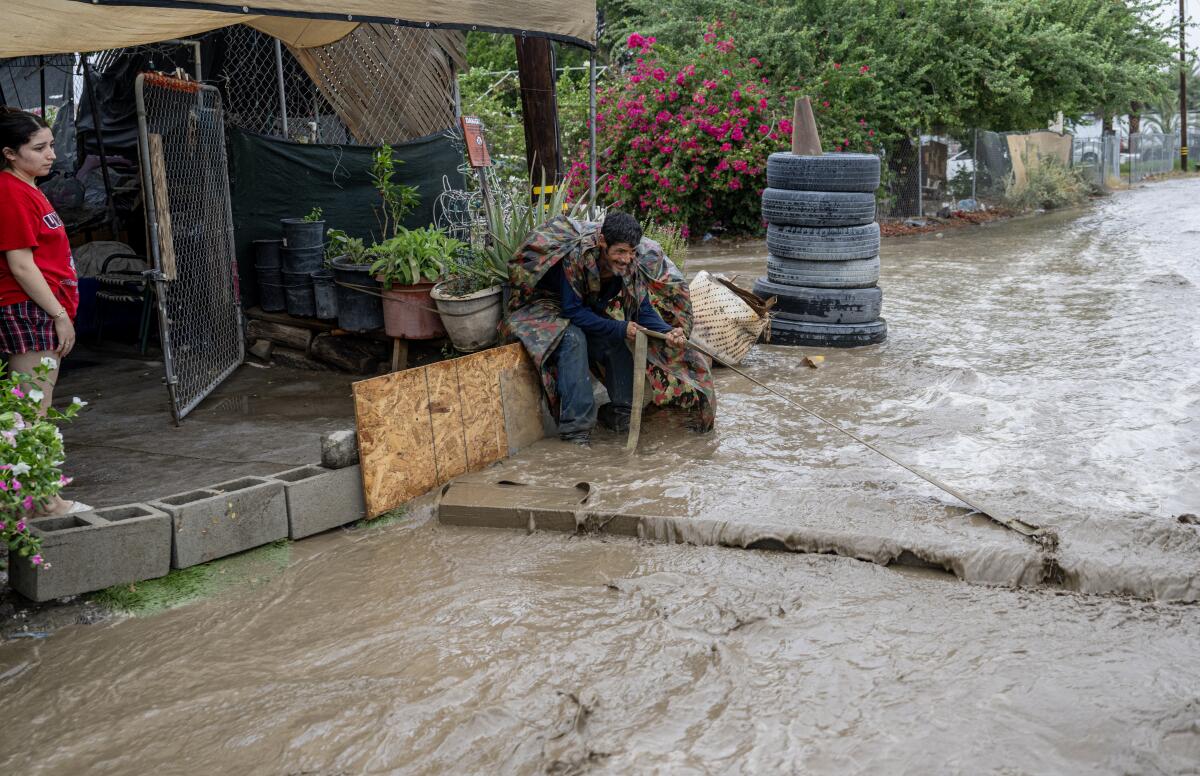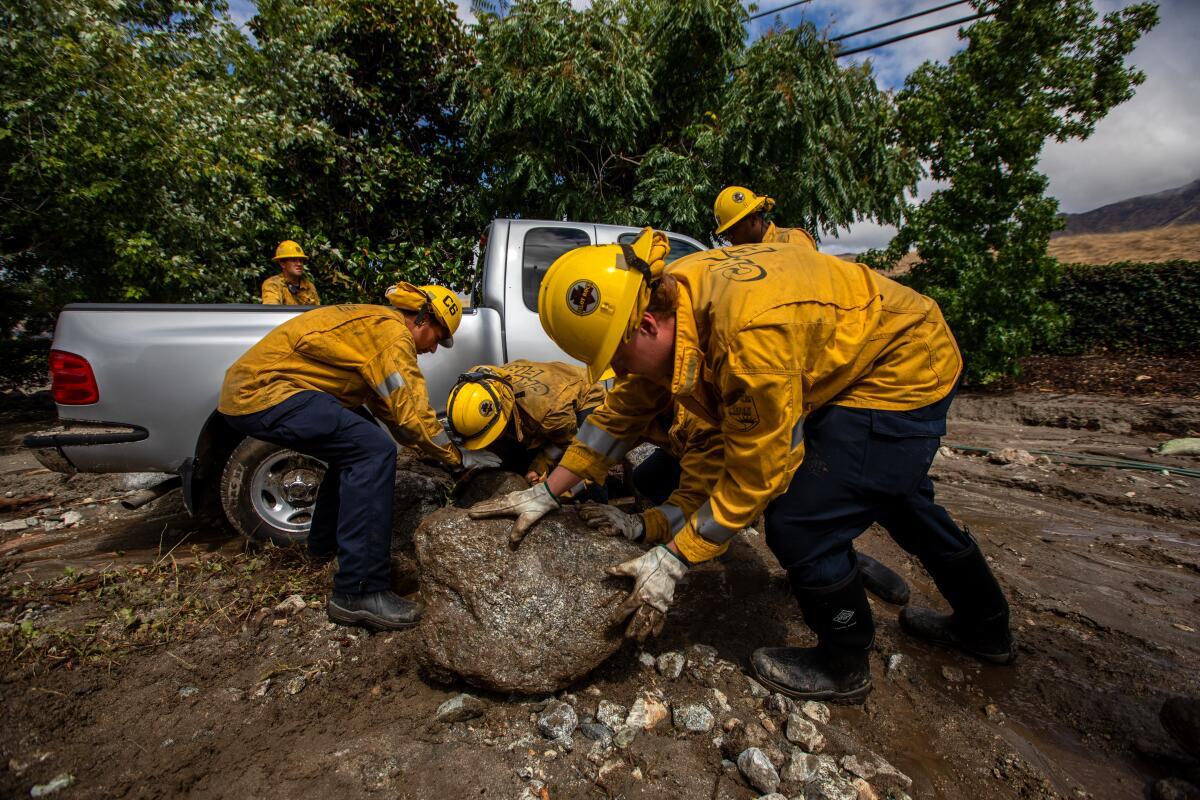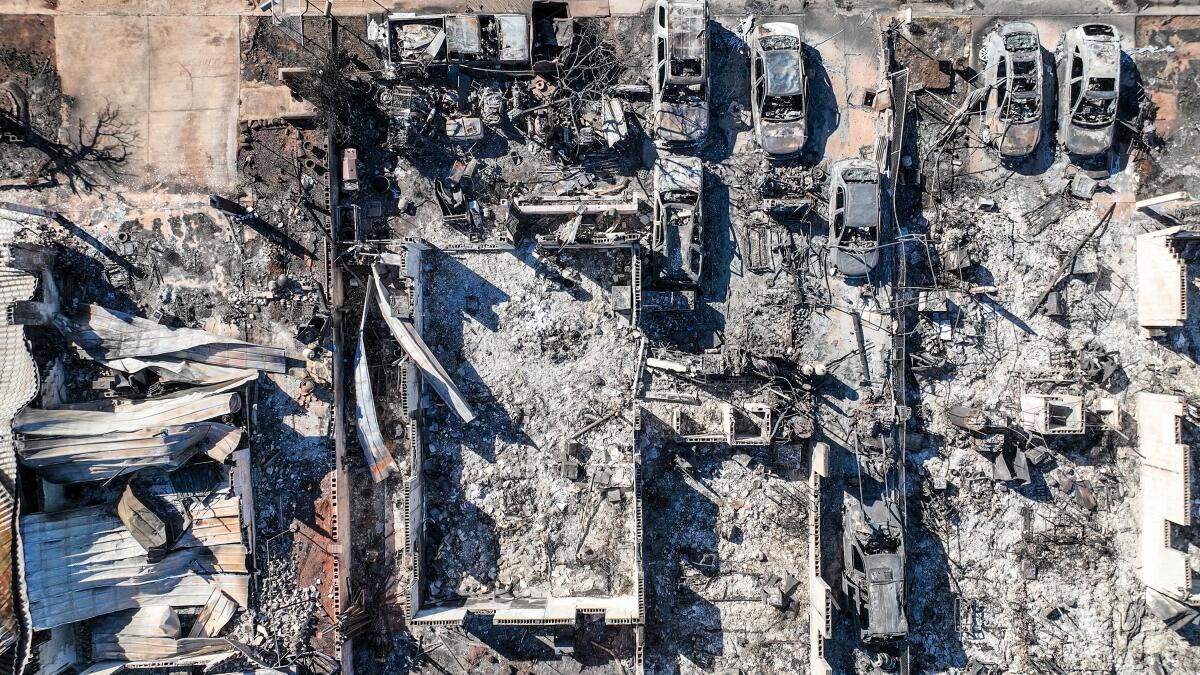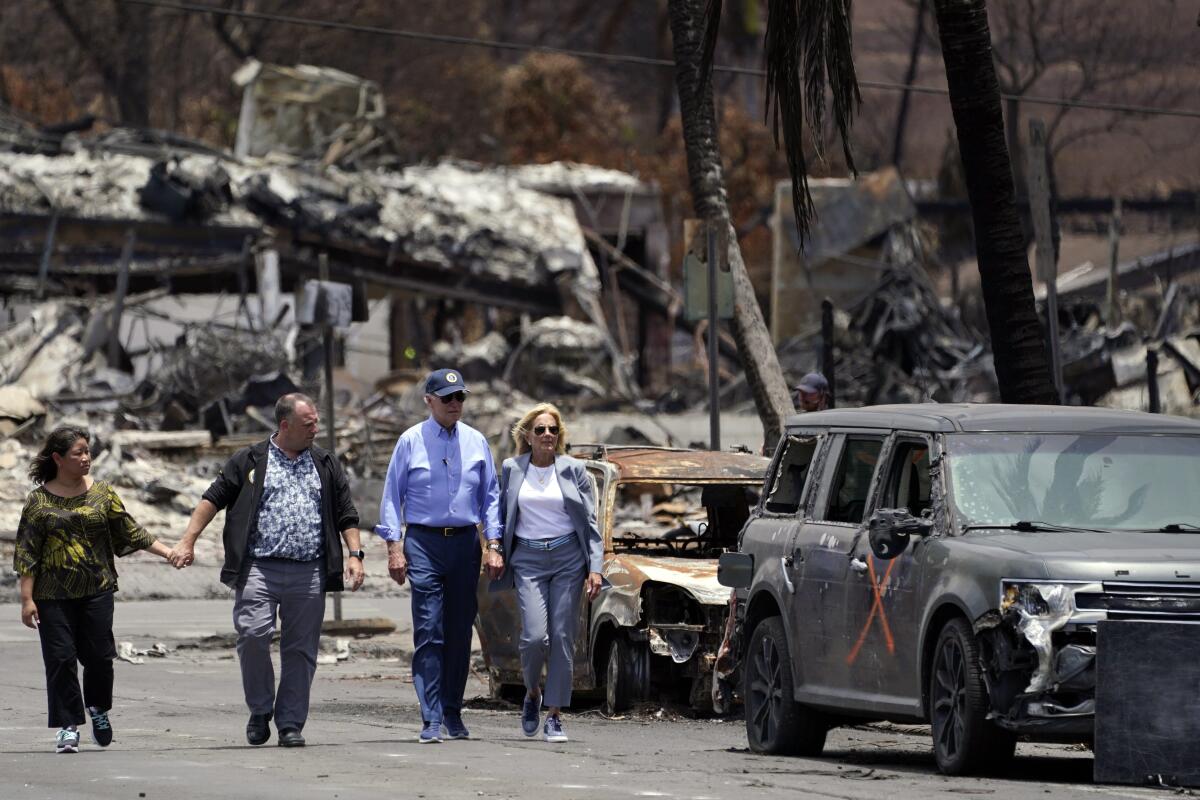Boiling Point: Southern California’s historic storm shows climate risk

- Share via
This story was originally published in Boiling Point, a weekly newsletter about climate change and the environment. Sign up here to get it in your inbox.
Hilary was a record-smasher.
The first tropical storm to hit Southern California in 84 years unleashed torrential rains and flooding, triggered flows of mud and debris, and buried roads in places from the San Bernardino Mountains to Death Valley.
The storm obliterated daily rainfall records in Los Angeles, Palmdale, La Verne and other areas, as my colleague Faith E. Pinho reports. Some locations saw 4 inches of rain or more on Sunday alone. At Mt. Wilson, more than 8 inches of rain fell.
Times journalists fanned out across Southern California to report on the storm.
In the San Bernardino Mountains, mud and debris flows rendered roads impassable and forced firefighters to run for safety. The Times’ Alexandra E. Petri, Grace Toohey and David Zahniser reported on the havoc, including flooding from the Antelope Valley to Ventura County, streets transformed into muddy, debris-swollen rivers, toppled trees and power lines, as well as many closed schools.

In parts of the Coachella Valley, where the rains sent desert mud coursing down streets, some people sought to block the waters from their mobile homes using whatever they had on hand, including pieces of sheet metal, my colleagues Brittny Mejia, Cari Spencer, Joe Mozingo and Jeong Park report. Times photographer Gina Ferazzi captured the scenes as residents watched floodwaters creep onto driveways and toward their homes.
It was a weekend of remarkably wild weather.
So, what factors put this powerful storm on a collision course for Southern California? My colleagues Tony Briscoe, Hayley Smith and Alex Wigglesworth delve into that question, explaining that an unusual set of weather patterns and warm Pacific Ocean waters created the conditions for the hurricane.
Some key points: July set a record for the highest monthly ocean surface temperature in the 174-year history of the National Oceanic and Atmospheric Administration. And ocean temperatures off the coast of Baja California are no exception, influenced by the warming effects of El Niño and global heating driven by the burning of fossil fuels.
Explaining the science, Kristy Dahl of the nonprofit Union of Concerned Scientists said: “Over the last 40 years, climate change has made hurricanes more powerful, both in terms of wind speed and the amount of water they deliver as rain.”
Scientists’ findings on how climate change affects hurricanes are detailed in the national climate assessment, which says that in a hotter world, there will be a greater potential for stronger tropical cyclones in all of the planet’s oceans. Researchers have found that since 1979, human-caused warming has increased the likelihood of such storms developing into a major hurricane.
In short, a warmer climate amplifies the water cycle and means more intense storms. And Hilary has given Southern California a taste of the intensifying storms that scientists say are becoming more likely as temperatures rise — the type of extreme deluge that shows the region’s vulnerability and points to a need to plan and prepare for worsening disasters.

While Hilary was approaching as a hurricane, Times reporter Corinne Purtill spoke with several experts about what’s going through their minds as they watch longstanding warnings about the effects of climate change coming to pass. As Craig Smith, an oceanographer at the University of Hawaii at Manoa, put it: “Climate change denial will cost us more and more lives.”
Jonathan Parfrey, executive director of the nonprofit Climate Resolve, said action to address the crisis “should be viewed as an act of survival, a necessity.”
In a post this week, emergency management expert Dr. Samantha Montano stressed that “we are only at the beginning of the climate-related disasters we will experience in our lifetimes.”
“We should really at least try to create an emergency management system that works effectively,” she wrote.
On that note, here’s what else is happening around the West:
TOP STORIES
The catastrophic fire that destroyed Lahaina was fueled by a mix of factors, among them strong winds and invasive grasses that had grown thickly on abandoned sugarcane plantations. As Hayley Smith reports, experts say such disasters are becoming increasingly likely as higher temperatures, development, land-use policies and other factors conspire to create conditions for fires — even in seemingly unexpected places. Fire historian Stephen Pyne told Smith that many factors combine to create the conditions of an age he calls the “Pyrocene,” which means “a lot of fire in our future” in many regions. He says the risks are being accelerated by global warming, which is like “putting the system on steroids.”

After the wildfire swept through Lahaina, residents organized to help their community. Times photojournalist Robert Gauthier documented these efforts as people collected emergency supplies, helped repair roofs and joined hands in prayer. Alex Wigglesworth looked into how a single house appeared oddly unscathed in the devastation, surrounded by the charred rubble along the waterfront.
Five years after the Camp fire devastated Paradise in the deadliest wildfire in California history, the town is one of the fastest growing in the state, with construction on nearly every block. My colleagues Anita Chabria and Jessica Garrison spoke with residents who are moving forward with their lives. State and federal funding has helped rebuild homes. Still, residents say they live with trauma. Barbara Bowen, who is back in a home in Paradise, said she feels that her community has fractured, and wishes she had not returned. “Even if you get back in a home, your life is forever changed,” she said.
On Aug. 6, two firefighting helicopters collided over a brush fire in Cabazon and crashed, killing three people. As the National Transportation Safety Board investigates the crash, a former wildland fire pilot is calling attention to the fact that one of the choppers lacked a traffic collision-avoidance system, or TCAS. He told Times reporter Alex Wigglesworth that he is shocked this system, which audibly alerts pilots when another aircraft is nearby, isn’t already required to be installed on contract helicopters.
POLITICAL CLIMATE
President Biden headed to Maui with FEMA Administrator Deanne Criswell to survey the damage left by the fire and meet with victims who lost family members. Noah Bierman reports for The Times that the federal government has more than 1,000 people in Maui, including 450 working on search and rescue. FEMA also has sent two teams to Southern California to manage the federal response to the flooding.

A proposal in Congress focusing on California’s giant sequoias is stirring debate. House Speaker Kevin McCarthy is a chief sponsor of the proposed bill, called the Save Our Sequoias Act, which has bipartisan support and would approve $205 million to protect sequoia groves. But as my colleague Erin B. Logan reports, the bill faces strong opposition from some environmental groups, including the Sierra Club, GreenLatinos and the Pacific Crest Trail Assn. They said in a letter that the proposal would undercut existing environmental protections and “expedite potentially harming logging projects.”
AROUND THE WEST
A controversial oil train that would carry crude along the Colorado River has been paused by a federal judge, who says more analysis of potential environmental harms is needed. Tom Hesse and Sam Brasch report for Colorado Public Radio that the court ruled that a federal board erred when it gave approval to a railway project in eastern Utah, and failed to properly assess and disclose potential risks and environmental damage.
There is a long list of contaminants that need to be monitored in drinking water, but Arizona environmental regulators say a state program that helps small water systems monitor contaminants is running out of funding. Clara Migoya wrote about the budget crunch for the Arizona Republic, pointing out that the cost of the program is expected to increase once federal regulators impose new rules to limit harmful PFAS, or “forever chemicals,” in drinking water.
Methane is a powerful greenhouse gas, and some large emitters include cattle operations. Reporters Phil McKenna, Georgina Gustin and Peter Aldhous of Inside Climate News investigated and found that the Brandt Cattle Co., a ranch in the Imperial Valley, is the largest single-point source of methane emissions in the state. According to their data analysis, the 643-acre feedlot, home to 139,000 beef cattle, is releasing more of the greenhouse gas “than any oil or gas well, refinery or landfill.”
THE ENERGY TRANSITION
President Biden recently said he has “practically” declared a climate emergency. The Times Editorial Board argues in an editorial that if the president is serious about fighting the climate crisis, “why not declare it an emergency for real?
Should you buy or lease solar panels? What about a battery? Jon Healey breaks down the economics and options in California in this helpful guide, which is part of a big upcoming Times series titled Our Climate Change Challenge.
ONE MORE THING
Did you happen to see a photo on social media showing what appeared to be Dodger Stadium surrounded by floodwater? Well, things sometimes aren’t as they appear.
My colleagues David Wharton and Robert Gauthier did a little research and the answer is no, the tropical storm did not transform Dodger Stadium into an island.
This is actually a phenomenon that appeared in a similar photo published in the newspaper after a 2005 storm. But it wasn’t flooding. As Wharton and Gauthier explain, it was an optical illusion, the deceptive appearance of light on the wet pavement.
And fans will be reassured that when Gauthier stopped by to check on Dodger Stadium on Monday, he found the parking lot was completely dry under sunny skies.
We’ll be back in your inbox on Thursday. To view this newsletter in your Web browser, click here. For more climate and environment news, follow me @ByIanJames — and @Sammy_Roth, the regular author of Boiling Point, who will be back soon.
Toward a more sustainable California
Get Boiling Point, our newsletter exploring climate change, energy and the environment, and become part of the conversation — and the solution.
You may occasionally receive promotional content from the Los Angeles Times.






